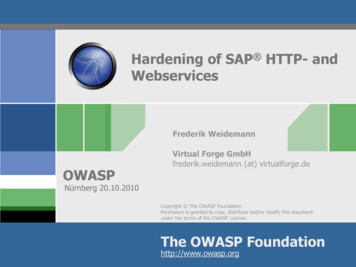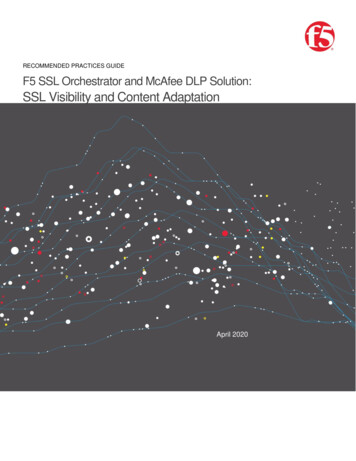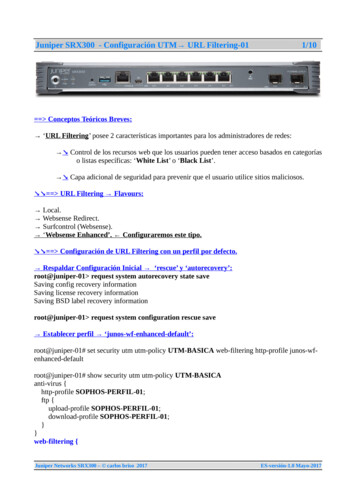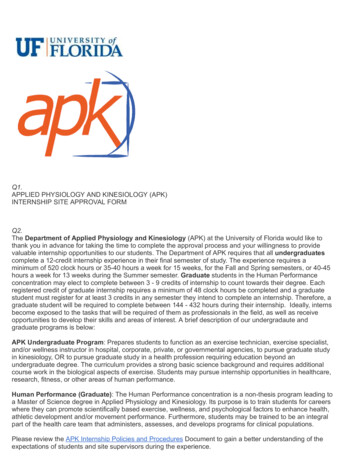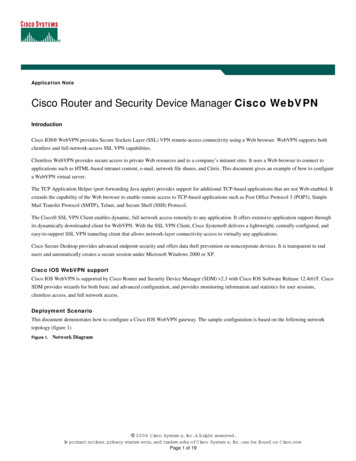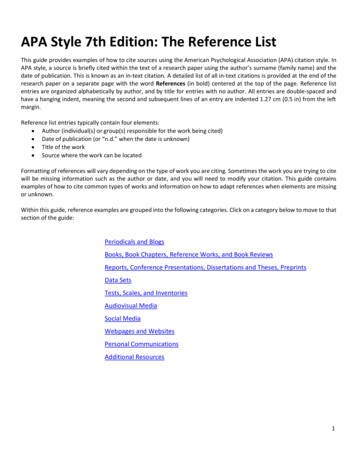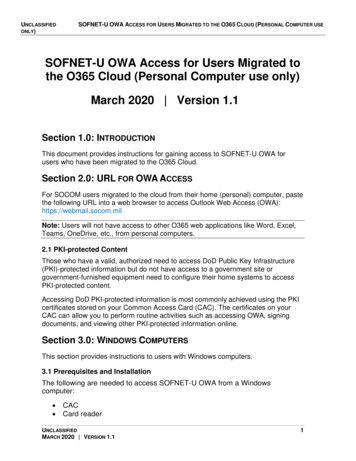
Transcription
Saylor URL: http://www.saylor.org/booksSaylor.org1
This text was adapted by The Saylor Foundation under a CreativeCommons Attribution-NonCommercial-ShareAlike 3.0 License withoutattribution as requested by the work’s original creator or licensee.Saylor URL: http://www.saylor.org/booksSaylor.org2
Chapter 1Why Public Speaking Matters TodayPublic Speaking in the Twenty-First CenturyPublic speaking is the process of designing and delivering a message to anaudience. Effective public speaking involves understanding your audience andspeaking goals, choosing elements for the speech that will engage youraudience with your topic, and delivering your message skillfully. Good publicspeakers understand that they must plan, organize, and revise their materialin order to develop an effective speech. This book will help you understand thebasics of effective public speaking and guide you through the process ofcreating your own presentations. We’ll begin by discussing the ways in whichpublic speaking is relevant to you and can benefit you in your career,education, and personal life.In a world where people are bombarded with messages through television,social media, and the Internet, one of the first questions you may ask is, “Dopeople still give speeches?” Well, type the words “public speaking” intoAmazon.com or Barnesandnoble.com, and you will find more than twothousand books with the words “public speaking” in the title. Most of theseand other books related to public speaking are not college textbooks. In fact,many books written about public speaking are intended for very specificaudiences: A Handbook of Public Speaking for Scientists and Engineers (byPeter Kenny), Excuse Me! Let Me Speak!: A Young Person’s Guide to PublicSpeaking (by Michelle J. Dyett-Welcome), Professionally Speaking: PublicSpeaking for Health Professionals (by Frank De Piano and Arnold Melnick),and Speaking Effectively: A Guide for Air Force Speakers(by John A. Kline).Although these different books address specific issues related to nurses,engineers, or air force officers, the content is basically the same. If you searchfor “public speaking” in an online academic database, you’ll find numerousSaylor URL: http://www.saylor.org/booksSaylor.org3
articles on public speaking in business magazines(e.g., BusinessWeek, Nonprofit World) and academic journals (e.g., HarvardBusiness Review, Journal of Business Communication). There is so muchinformation available about public speaking because it continues to berelevant even with the growth of technological means of communication. Asauthor and speaker Scott Berkun writes in his blog, “For all our tech, we’re stillvery fond of the most low tech thing there is: a monologue.” [1] People continueto spend millions of dollars every year to listen to professional speakers. Forexample, attendees of the 2010 TED (Technology, Entertainment, Design)conference, which invites speakers from around the world to share their ideasin short, eighteen-minute presentations, paid six thousand dollars per personto listen to fifty speeches over a four-day period.Technology can also help public speakers reach audiences that were notpossible to reach in the past. Millions of people heard about and then watchedRandy Pausch’s “Last Lecture” online. In this captivating speech, RandyPausch, a Carnegie Mellon University professor who retired at age forty-sixafter developing inoperable tumors, delivered his last lecture to the students,faculty, and staff. This inspiring speech was turned into a DVD and a bestselling book that was eventually published in more than thirty-fivelanguages.[2]We realize that you may not be invited to TED to give the speech of your life orcreate a speech so inspirational that it touches the lives of millions viaYouTube; however, all of us will find ourselves in situations where we will beasked to give a speech, make a presentation, or just deliver a few words. In thischapter, we will first address why public speaking is important, and then wewill discuss models that illustrate the process of public speaking itself.Saylor URL: http://www.saylor.org/booksSaylor.org4
1.1 Why Is Public Speaking Important?LEARNING OBJECTIVES1. Explore three types of public speaking in everyday life: informative, persuasive,and entertaining.2. Understand the benefits of taking a course in public speaking.3. Explain the benefits people get from engaging in public speaking.In today’s world, we are constantly bombarded with messages both good andbad. No matter where you live, where you work or go to school, or what kindsof media you use, you are probably exposed to hundreds. if not thousands, ofadvertising messages every day. Researcher Norman W. Edmund estimatesthat by 2020 the amount of knowledge in the world will double every seventythree days. [1] Because we live in a world where we are overwhelmed withcontent, communicating information in a way that is accessible to others ismore important today than ever before. To help us further understand whypublic speaking is important, we will first examine public speaking in everydaylife. We will then discuss how public speaking can benefit you personally.Everyday Public SpeakingEvery single day people across the United States and around the world standup in front of some kind of audience and speak. In fact, there’s even a monthlypublication that reproduces some of the top speeches from around the UnitedStates called Vital Speeches of the Day (http://www.vsotd.com). Althoughpublic speeches are of various types, they can generally be grouped into threecategories based on their intended purpose: informative, persuasive, andentertaining.1.2 The Process of Public SpeakingSaylor URL: http://www.saylor.org/booksSaylor.org5
LEARNING OBJECTIVES1. Identify the three components of getting your message across to others.2. Distinguish between the interactional models of communication and thetransactional model of communication.3. Explain the three principles discussed in the dialogical theory of public speaking.As noted earlier, all of us encounter thousands of messages in our everydayenvironments, so getting your idea heard above all the other ones is a constantbattle. Some speakers will try gimmicks, but we strongly believe that gettingyour message heard depends on three fundamental components: message,skill, and passion. The first part of getting your message across is the messageitself. When what you are saying is clear and coherent, people are more likelyto pay attention to it. On the other hand, when a message is ambiguous,people will often stop paying attention. Our discussions in the first part of thisbook involve how to have clear and coherent content.The second part of getting your message heard is having effectivecommunication skills. You may have the best ideas in the world, but if you donot possess basic public speaking skills, you’re going to have a problem gettinganyone to listen. In this book, we will address the skills you must possess toeffectively communicate your ideas to others.Lastly, if you want your message to be heard, you must communicate passionfor your message. One mistake that novice public speakers make is pickingtopics in which they have no emotional investment. If an audience can tell thatyou don’t really care about your topic, they will just tune you out. Passion isthe extra spark that draws people’s attention and makes them want to listen toyour message.In this section, we’re going to examine the process of public speaking by firstintroducing you to a basic model of public speaking and then discussing howpublic speaking functions as dialogue. These models will give you a basicSaylor URL: http://www.saylor.org/booksSaylor.org6
understanding of the communication process and some challenges that youmay face as a speaker.Models of Public SpeakingA basic model of human communication is one of the first topics that mostcommunication teachers start with in any class. For our focus on publicspeaking, we will introduce two widely discussed models in communication:interactional and transactional.Interactional Model of Public SpeakingLinear ModelThe interactional model of public speaking comes from the work of ClaudeShannon and Warren Weaver. [1] The original model mirrored how radio andtelephone technologies functioned and consisted of three primary parts:source, channel, and receiver. Thesource was the part of a telephone a personspoke into, the channel was the telephone itself, and the receiver was the partof the phone where one could hear the other person. Shannon and Weaveralso recognized that often there is static that interferes with listening to atelephone conversation, which they called noise.Although there are a number of problems with applying this model to humancommunication, it does have some useful parallels to public speaking. Inpublic speaking, the source is the person who is giving the speech, the channelis the speaker’s use ofverbal and nonverbal communication, and the receiversSaylor URL: http://www.saylor.org/booksSaylor.org7
are the audience members listening to the speech. As with a telephone call, awide range of distractions (noise) can inhibit an audience member fromaccurately attending to a speaker’s speech. Avoiding or adapting to these typesof noise is an important challenge for public speakers.Interactional ModelThe interactional model of communication developed by Wilbur Schrammbuilds upon the linear model. [2] Schramm added three major components tothe Shannon and Weaver model. First, Schramm identified two basicprocesses of communication: encoding and decoding. Encoding is what asource does when “creating a message, adapting it to the receiver, andtransmitting it across some source-selected channel.” [3] When you are at homepreparing your speech or standing in front of your classroom talking to yourpeers, you are participating in the encoding process.The second major process is the decoding process, or “sensing (for example,hearing or seeing) a source’s message, interpreting the source’s message,evaluating the source’s message, and responding to the source’smessage.” [4] Decoding is relevant in the public speaking context when, as anaudience member, you listen to the words of the speech, pay attention tononverbal behaviors of the speaker, and attend to any presentation aids thatthe speaker uses. You must then interpret what the speaker is saying.Saylor URL: http://www.saylor.org/booksSaylor.org8
Although interpreting a speaker’s message may sound easy in theory, inpractice many problems can arise. A speaker’s verbal message, nonverbalcommunication, and mediated presentation aids can all make a message eitherclearer or harder to understand. For example, unfamiliar vocabulary, speakingtoo fast or too softly, or small print on presentation aids may make it difficultfor you to figure out what the speaker means. Conversely, by providingdefinitions of complex terms, using well-timed gestures, or displaying graphsof quantitative information, the speaker can help you interpret his or hermeaning.Once you have interpreted what the speaker is communicating, you thenevaluate the message. Was it good? Do you agree or disagree with the speaker?Is a speaker’s argument logical? These are all questions that you may askyourself when evaluating a speech.The last part of decoding is “responding to a source’s message,” when thereceiver encodes a message to send to the source. When a receiver sends amessage back to a source, we call this process feedback. Schramm talks aboutthree types of feedback: direct, moderately direct, and indirect. [5] The firsttype, direct feedback, occurs when the receiver directly talks to the source. Forexample, if a speech ends with a question-and-answer period, listeners willopenly agree or disagree with the speaker. The second type of feedback,moderately direct, focuses on nonverbal messages sent while a source isspeaking, such as audience members smiling and nodding their heads inagreement or looking at their watches or surreptitiously sending text messagesduring the speech. The final type of feedback, indirect, often involves a greatertime gap between the actual message and the receiver’s feedback. Forexample, suppose you run for student body president and give speeches to avariety of groups all over campus, only to lose on student election day. Youraudiences (the different groups you spoke to) have offered you indirectfeedback on your message through their votes. One of the challenges you’llSaylor URL: http://www.saylor.org/booksSaylor.org9
face as a public speaker is how to respond effectively to audience feedback,particularly the direct and moderately direct forms of feedback you receiveduring your presentation.Transactional Model of Public SpeakingOne of the biggest concerns that some people have with the interactionalmodel of communication is that it tends to place people into the category ofeither source or receiver with no overlap. Even with Schramm’s model,encoding and decoding are perceived as distinct for sources and receivers.Furthermore, the interactional model cannot handle situations where multiplesources are interacting at the same time. [6] To address these weaknesses, DeanBarnlund proposed a transactional model of communication. [7] The basicpremise of the transactional model is that individuals are sending andreceiving messages at the same time. Whereas the interactional model hasSaylor URL: http://www.saylor.org/booksSaylor.org10
individuals engaging in the role of either source or receiver and the meaning ofa message is sent from the source to the receiver, the transactional modelassumes that meaning is cocreated by both people interacting together.The idea that meanings are cocreated between people is based on a conceptcalled the “field of experience.” According to West and Turner, a field ofexperience involves “how a person’s culture, experiences, and heredityinfluence his or her ability to communicate with another.” [8] Our education,race, gender, ethnicity, religion, personality, beliefs, actions, attitudes,languages, social status, past experiences, and customs are all aspects of ourfield of experience, which we bring to every interaction. For meaning to occur,we must have some shared experiences with our audience; this makes itchallenging to speak effectively to audiences with very different experiencesfrom our own. Our goal as public speakers is to build upon shared fields ofexperience so that we can help audience members interpret our message.Dialogic Theory of Public SpeakingMost people think of public speaking as engaging in a monologue where thespeaker stands and delivers information and the audience passively listens.Based on the work of numerous philosophers, however, Ronald Arnett and PatArneson proposed that all communication, even public speaking, could beviewed as a dialogue. [9] The dialogic theory is based on three overarchingprinciples:1. Dialogue is more natural than monologue.2. Meanings are in people not words.3. Contexts and social situations impact perceived meanings. [10]Let’s look at each of these in turn.Saylor URL: http://www.saylor.org/booksSaylor.org11
Dialogue vs. MonologueThe first tenet of the dialogic perspective is that communication should be adialogue and not a monologue. Lev Yakubinsky argued that even publicspeaking situations often turn into dialogues when audience members activelyengage speakers by asking questions. He even claimed that nonverbalbehavior (e.g., nodding one’s head in agreement or scowling) functions asfeedback for speakers and contributes to a dialogue. [11] Overall, if youapproach your public speaking experience as a dialogue, you’ll be moreactively engaged as a speaker and more attentive to how your audience isresponding, which will, in turn, lead to more actively engaged audiencemembers.Meanings Are in People, Not WordsPart of the dialogic process in public speaking is realizing that you and youraudience may differ in how you see your speech. Hellmut Geissner and EdithSlembeck (1986) discussed Geissner’s idea of responsibility, or the notion thatthe meanings of words must be mutually agreed upon by people interactingwith each other. [12] If you say the word “dog” and think of a soft, furry pet andyour audience member thinks of the animal that attacked him as a child, thetwo of you perceive the word from very different vantage points. As speakers,we must do our best to craft messages that take our audience into account anduse audience feedback to determine whether the meaning we intend is the onethat is received. To be successful at conveying our desired meaning, we mustknow quite a bit about our audience so we can make language choices that willbe the most appropriate for the context. Although we cannot predict how allour audience members will interpret specific words, we do know that—forexample—using teenage slang when speaking to the audience at a seniorcenter would most likely hurt our ability to convey our meaning clearly.Saylor URL: http://www.saylor.org/booksSaylor.org12
Contexts and Social SituationsRussian scholar Mikhail Bahktin notes that human interactions take placeaccording to cultural norms and rules. [13] How we approach people, the wordswe choose, and how we deliver speeches are all dependent on differentspeaking contexts and social situations. On September 8, 2009, PresidentBarack Obama addressed school children with a televised eparedSchoolRemarks). Ifyou look at the speech he delivered to kids around the country and then at hisspeeches targeted toward adults, you’ll see lots of differences. These dissimilarspeeches are necessary because the audiences (speaking to kids vs. speaking toadults) have different experiences and levels of knowledge. Ultimately, goodpublic speaking is a matter of taking into account the cultural background ofyour audience and attempting to engage your audience in a dialogue fromtheir own vantage point.Considering the context of a public speech involves thinking about fourdimensions: physical, temporal, social-psychological, and cultural. [14]Physical DimensionThe physical dimension of communication involves the real or touchableenvironment where communication occurs. For example, you may findyourself speaking in a classroom, a corporate board room, or a largeamphitheater. Each of these real environments will influence your ability tointeract with your audience. Larger physical spaces may require you to use amicrophone and speaker system to make yourself heard or to use projectedpresentation aids to convey visual material.How the room is physically decorated or designed can also impact yourinteraction with your audience. If the room is dimly lit or is decorated withinteresting posters, audience members’ minds may start wandering. If theroom is too hot, you’ll find people becoming sleepy. As speakers, we often haveSaylor URL: http://www.saylor.org/booksSaylor.org13
little or no control over our physical environment, but we always need to takeit into account when planning and delivering our messages.Temporal DimensionAccording to Joseph DeVito, the temporal dimension “has to do not only withthe time of day and moment in history but also with where a particularmessage fits into the sequence of communication events.” [15] The time of daycan have a dramatic effect on how alert one’s audience is. Don’t believe us? Trygiving a speech in front of a class around 12:30 p.m. when no one’s had lunch.It’s amazing how impatient audience members get once hunger sets in.In addition to the time of day, we often face temporal dimensions related tohow our speech will be viewed in light of societal events. Imagine how aspeech on the importance of campus security would be interpreted on the dayafter a shooting occurred. Compare this with the interpretation of the samespeech given at a time when the campus had not had any shootings for years,if ever.Another element of the temporal dimension is how a message fits with whathappens immediately before it. For example, if another speaker has just givenan intense speech on death and dying and you stand up to speak aboutsomething more trivial, people may downplay your message because it doesn’tfit with the serious tone established by the earlier speech. You never want tobe the funny speaker who has to follow an emotional speech where peoplecried. Most of the time in a speech class, you will have no advance notice as towhat the speaker before you will be talking about. Therefore, it is wise to planon being sensitive to previous topics and be prepared to ease your way subtlyinto your message if the situation so dictates.Saylor URL: http://www.saylor.org/booksSaylor.org14
Social-Psychological DimensionThe social-psychological dimension of context refers to “status relationshipsamong participants, roles and games that people play, norms of the society orgroup, and the friendliness, formality, or gravity of the situation.” [16] You haveto know the types of people in your audience and how they react to a widerange of messages.Cultural DimensionThe final context dimension Joseph DeVito mentions is the culturaldimension. [17]When we interact with others from different cultures,misunderstandings can result from differing cultural beliefs, norms, andpractices. As public speakers engaging in a dialogue with our audiencemembers, we must attempt to understand the cultural makeup of ouraudience so that we can avoid these misunderstandings as much as possible.Each of these elements of context is a challenge for you as a speaker.Throughout the rest of the book, we’ll discuss how you can meet the challengespresented by the audience and context and become a more effective publicspeaker in the process.KEY TAKEAWAYS Getting your message across to others effectively requires attention to messagecontent, skill in communicating content, and your passion for the informationpresented. The interactional models of communication provide a useful foundation forunderstanding communication and outline basic concepts such as sender,receiver, noise, message, channel, encoding, decoding, and feedback. Thetransactional model builds on the interactional models by recognizing thatpeople can enact the roles of sender and receiver simultaneously and thatinteractants cocreate meaning through shared fields of experience.Saylor URL: http://www.saylor.org/booksSaylor.org15
The dialogic theory of public speaking understands public speaking as adialogue between speaker and audience. This dialogue requires the speaker tounderstand that meaning depends on the speaker’s and hearer’s vantage pointsand that context affects how we must design and deliver our messages.EXERCISES1. Draw the major models of communication on a piece of paper and then explainhow each component is important to public speaking.2. When thinking about your first speech in class, explain the context of yourspeech using DeVito’s four dimensions: physical, temporal, social-psychological,and cultural. How might you address challenges posed by each of these fourdimensions?1.3 Chapter ExercisesEND-OF-CHAPTER ASSESSMENT1. José is a widely sought-after speaker on the topic of environmentalpollution. He’s written numerous books on the topic and is always seenas the “go-to” guy by news channels when the topic surfaces. What isJosé? A. thought leader B. innovator C. business strategist D. rhetoricalexpert E. intellectual capitalistFatima is getting ready for a speech she is delivering to theUnited Nations. She realizes that there are a range of relationshipsamong her various audience members. Furthermore, the UnitedNations has a variety of norms that are specific to that context. Whichof DeVito’s (2009) four aspects of communication context is Fatimaconcerned with? A. physical B. temporal C. social-psychological D.cultural E. rhetoricalANSWER KEY1. aSaylor URL: http://www.saylor.org/booksSaylor.org16
2. cSaylor URL: http://www.saylor.org/booksSaylor.org17
Chapter 2Ethics Matters: Understanding the Ethics of PublicSpeakingEthics TodayEvery day, people around the world make ethical decisions regarding public speech. Is it ever appropriateto lie to a group of people if it’s in the group’s best interest? As a speaker, should you use evidence within aspeech that you are not sure is correct if it supports the speech’s core argument? As a listener, should yourefuse to listen to a speaker with whom you fundamentally disagree? These three examples representethical choices speakers and listeners face in the public speaking context. In this chapter, we will explorewhat it means to be both an ethical speaker and an ethical listener. To help you understand the issuesinvolved with thinking about ethics, this chapter begins by presenting a model for ethical communicationknown as the ethics pyramid. We will then show how the National Communication Association (NCA)Credo for Ethical Communication can be applied to public speaking. The chapter will conclude with ageneral discussion of free speech.2.1 The Ethics PyramidLEARNING OBJECTIVE1. Explain how the three levels of the ethics pyramid might be used in evaluatingthe ethical choices of a public speaker or listener.The word “ethics” can mean different things to different people. Whether it isan ethical lapse in business or politics or a disagreement about medicaltreatments and end-of-life choices, people come into contact with ethicaldilemmas regularly. Speakers and listeners of public speech face numerousethical dilemmas as well. What kinds of support material and sources areSaylor URL: http://www.saylor.org/booksSaylor.org18
ethical to use? How much should a speaker adapt to an audience withoutsacrificing his or her own views? What makes a speech ethical?Figure 2.1 Ethical PyramidElspeth Tilley, a public communication ethics expert from Massey University,proposes a structured approach to thinking about ethics. [1] Her ethics pyramidinvolves three basic concepts: intent, means, and ends. Figure 2.1 "EthicalPyramid" illustrates the Tilley pyramid.IntentAccording to Tilley, the first major consideration to be aware of whenexamining the ethicality of something is the issue of intent. To be an ethicalspeaker or listener, it is important to begin with ethical intentions. Forexample, if we agree that honesty is ethical, it follows that ethical speakers willprepare their remarks with the intention of telling the truth to their audiences.Similarly, if we agree that it is ethical to listen with an open mind, it followsthat ethical listeners will be intentional about letting a speaker make his or hercase before forming judgments.One option for assessing intent is to talk with others about how ethical theythink a behavior is; if you get a variety of answers, it might be a sign that thebehavior is not ethical and should be avoided. A second option is to check outexisting codes of ethics. Many professional organizations, including theSaylor URL: http://www.saylor.org/booksSaylor.org19
Independent Computer Consultants Association, American CounselingAssociation, and American Society of Home Inspectors, have codes of conductor ethical guidelines for their members. Individual corporations such asMonsanto, Coca-Cola, Intel, and ConocoPhillips also have ethical guidelinesfor how their employees should interact with suppliers or clients. Even whenspecific ethical codes are not present, you can apply general ethical principles,such as whether a behavior is beneficial for the majority or whether you wouldapprove of the same behavior if you were listening to a speech instead ofgiving it.In addition, it is important to be aware that people can engage in unethicalbehavior unintentionally. For example, suppose we agree that it is unethical totake someone else’s words and pass them off as your own—a behavior knownas plagiarism. What happens if a speaker makes a statement that he believeshe thought of on his own, but the statement is actually quoted from a radiocommentator whom he heard without clearly remembering doing so? Theplagiarism was unintentional, but does that make it ethical?MeansTilley describes the means you use to communicate with others as the secondlevel of the ethics pyramid. According to McCroskey, Wrench, andRichmond, [2] “means” are the tools or behaviors we employ to achieve adesired outcome. We must realize that there are a range of possible behavioralchoices for any situation and that some choices are good, some are bad, andsome fall in between.For example, suppose you want your friend Marty to spend an hour reviewinga draft of your speech according to criteria, such as audience appropriateness,adequate research, strong support of assertions, and dynamic introductionand conclusion. What means might you use to persuade Marty to do you thisfavor? You might explain that you value Marty’s opinion and will gladly returnSaylor URL: http://www.saylor.org/booksSaylor.org20
the favor the next time Marty is preparing a speech (good means), or youmight threaten to tell a professor that Marty cheated on a test (bad means).While both of these means may lead to the same end—having Marty agree toreview your speech—one is clearly more ethical than the other.EndsThe final part of the ethics pyramid is the ends. According to McCroskey,Wrench, and Richmond, [3] ends are those outcomes that you desire to achieve.Examples of ends might include persuading your audience to make a financialcontribution for your participation in Relay for Life, persuading a group ofhomeowners that your real estate agency would best meet their needs, orinforming your fellow students about newly required university fees. Whereasthe means are the behavioral choices we make, the ends are the results ofthose choices.Like intentions and means, ends can be good or bad, or they can fall into agray area where it is unclear just how ethical or unethical they are. Forexample,
Well, type the words “public speaking” into Amazon.com or Barnesandnoble.com, and you will find more than two thousand books with the words “public speaking” in the title. Most of these and other books related to public speaking are not college textbooks. In fact, many books written about
